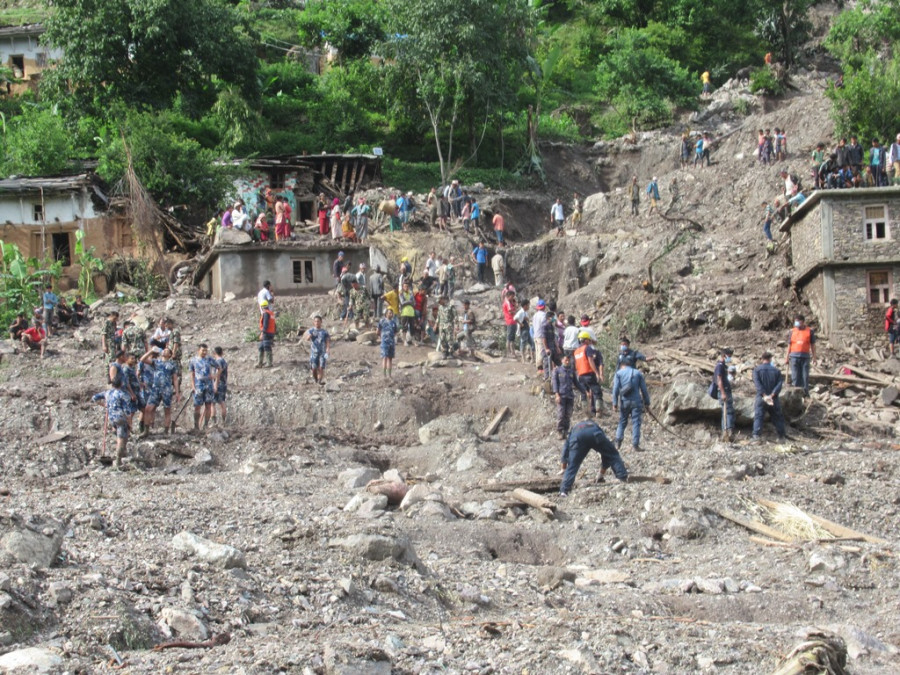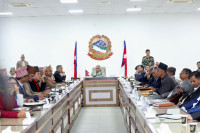National
Despite tackling disasters every monsoon, Nepal fails to learn from experience
Local governments should be empowered to prepare in advance and respond effectively when disasters strike, they say.
Chandan Kumar Mandal
For Jai Bahadur Shrestha of Bahrabise, Sindhupalchok district, a flooded Bhotekoshi is a recurring sight every monsoon season. But this time around it was not this mighty river that brought suffering to his settlement.
The Almo Thado Khola and Kabre Khola, tributaries of the Bhotekoshi, were the ones to wreak havoc last week. The flash flood killed at least two people and 17 others are still missing.
Incessant rain in the first two days was not the only reason for the floods. Haphazard construction is equally to blame. “Everyone wants a road right up to their doorstep. In addition to that, houses are being built on the banks of rivers like the Bhotekoshi,” said Shrestha. And they say, the river always reclaims its territory every few years.
With at least 115 people killed and 50 missing in various water-induced disasters between June 13 and July 13, soon after the monsoon arrived in Nepal, it is already turning out to be one of deadliest rainy seasons in the last 11 years.
“We’ve seen a massive loss of life and property in the country,” said Anil Pokhrel, chief executive at the National Disaster Risk Reduction and Management Authority, a body formed in 2019 under the Ministry of Home Affairs.
While people at the local level blame the loss of life due to flooding and landslides on the heavy rains and the unplanned construction of roads and houses, experts point out other reasons too and the failure to efficiently respond to disasters.
The loss of life and property points towards the failure of all tiers of government, especially the local level, as the authorities failed not only to plan their response to such calamities, but also to anticipate such events by learning from the past in a country prone to water-induced disasters.
It is the people who bear the brunt.
“The local government neither warned about a possible disaster nor did it help us plan for it,” said Shrestha of Bahrabise, who owns a bookshop and has lived in the river town all his life.
With the federal set-up in place, local governments should now be empowered to plan and respond to disasters, said Madhukar Upadhya, a climate change expert and watershed management practitioner.
“We see landslides and other disasters across the country every year,” said Upadhya. “There is an administrative set-up from the centre down to the local level, but the kind of response required to avert disasters and minimise the damage is missing,” said Upadhya.
With its diverse topography, complex geology and highly diverse climate,
Nepal remains vulnerable to many natural and human-induced hazards, says the Disaster Risk Reduction in Nepal: Status Report 2019. Floods kill nearly 150 people in Nepal every year. In the last nine years, 800 have died due to floods and another 900 in landslides. More than 700 are still labelled as missing.
“For unprecedented crises such as the Covid-19 pandemic and locust invasion, we may be unable to prepare in advance. But in the case of water-induced disasters, we could have been more alert,” said Upadhyay.
Experts emphasise that the local government’s access to disaster-related information needs to be improved.
“Local governments know where debris is flowing, and where a disaster is waiting to happen,” Upadhyay said. “When they are armed with information they can provide early warning to the people at a short notice.”
Basanta Raj Adhikari, an engineering geologist, pointed out that all the major national and international disaster conventions prioritise dissemination of scientific information to the community. He too points out local governments have a key role to play in this.
“Newly-elected leaders should at least have a basic understanding of disaster risk reduction,” said Adhikari.
Local governments also hold the key to disaster management and response as climate change and seismic hazards aggravate the threat of disasters in the country, researchers say.
In a country prone to earthquakes, like the one in 2015 that killed nearly 9,000 people, seismic activities bring changes to the hilly landscape, sometimes making them more prone to landslides.
Besides, Nepal ranks fourth in terms of climate risk, according to the Global Climate Risk Index that analyses the extent countries and regions have been affected by the impacts of weather-related events. An analysis of data on extreme weather events between 1999 and 2018 put Nepal ninth among the countries most affected by extreme weather events. Such rankings for Nepal indicate that the country could be hit by natural calamities anytime.
Irregular and high-intensity rainfall in the country in the past few years has already been associated with the impacts of climate change. In a warming world, more landslides will take place across the Himalayas, studies have shown.
The Bhotekoshi is a case in point. “Studies have suggested that the Bhotekoshi catchment is at risk,” said Upadhya. “Concentrated and high-intensity rainfall coupled with debris flow into the river amplified the damage,” said Upadhya.
The impact of the 2015 earthquake on Sindhupalchok, one of the worst-hit districts in terms of casualties, continues, said Adhikari, who is also an assistant professor at the Institute of Engineering, Pulchowk.
“When the Chi-Chi earthquake hit Taiwan in 1999 and rattled mountains there, it took a minimum of five years for it to settle. The same thing is happening in the case of Nepal after the 2015 earthquake. The mountains here had been much rattled,” Adhikari added. As the surface became weak, sand, boulders, and debris probably started flowing. “This was anticipated in earthquake-hit areas such as Sindhupalchok, but it did not occur in the last four years due to a relatively weaker monsoon.”
Despite the prediction of such a scenario post-earthquake, people continue to live in fragile areas. As a result, during a severe monsoon fatalities can be high. This is where the role of the local governments is especially pertinent, said Adhikari.
According to Upadhya, the first step towards empowering local governments and making people aware of the situation is through improved localised weather forecasting. “Mere rainfall predictions are not enough because rainfall trends show that heavy rainfall can take place in a small area. Authorities, therefore, need to provide weather forecast for smaller areas rather than just provinces and districts,” said Upadhya.
“Earlier, we used to get weather forecasts for five [development] regions. But these days, it has been expanded to seven provinces. In fact, it should at least cover the districts so that the public can stay alert,” Upadhya said.
Although Jai Bahadur Shrestha and his neighbours have borne the brunt of the landslides and flooding, it may not be over for this year. With more rains still to come in the next couple of months, as the monsoon continues, it might be the Bhotekoshi’s turn to reclaim its banks.
“Despite embracing a federal set-up, our centralised mentality has not changed,” said Adhikari. “Strengthening the local level is fundamental. In Nepal, people forget about preparedness once the disaster has passed. If we don’t change our ways, disaster response will remain the same for decades to come.”




 14.12°C Kathmandu
14.12°C Kathmandu





.jpg&w=200&height=120)









